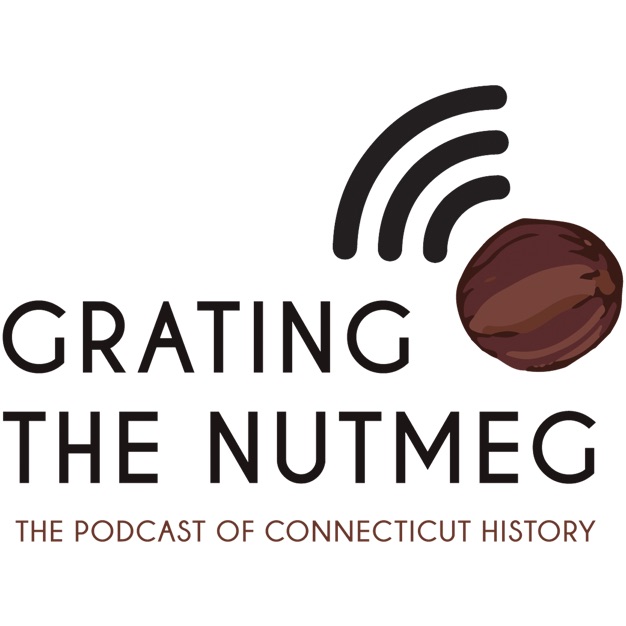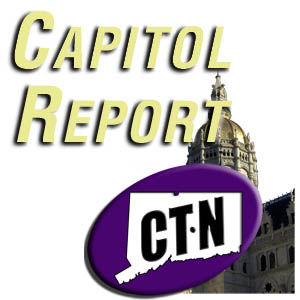
Grating the Nutmeg
State Historian and Connecticut Explored
Grating the Nutmeg scratches beneath the surface of Connecticut's history with stories from Connecticut Explored, the state's most popular history magazine, and new content unique to this podcast. All are stories about the past well worth hearing in the present. A joint production of the State Historian and Connecticut Explored, our goal is to give you great history you look forward to listening to
- 58 minutes 24 seconds201. The Friday Afternoon Club: A Family Memoir with Griffin Dunne
In this episode, Host Mary Donohue talks to Griffin Dunne, actor, producer and director and now New York Times best-selling author about his family memoir The Friday Afternoon Club. His Hartford to Hollywood family includes generations of writers, movie producers, journalists, and actors including his father Dominick Dunne, uncle John Gregory Dunne, and aunt Joan Didion.
This prominent family dynasty has part of its roots in Irish-American Connecticut, coming from Ireland to Derby and Hartford. Irish Catholics, unwelcome in Protestant Connecticut from the jump in the 1820s, nevertheless made Connecticut home. In this episode, Dunne shares stories about family figures such as Hartford’s Dominick Burns, a self-made man who immigrated from Ireland at age 11 and became a business owner and bank president. And Dr. Edwin Dunne, a Harvard-trained surgeon, who was the grandson of an Irish immigrant and the son of a machinist at the Farrell Foundry and Machine Company in Ansonia. And we don’t forget the Hollywood part of the story either with Dunne’s vivid memories of his father’s life as a movie producer and crime journalist!
Our thanks again to Griffin Dunne for joining us for this episode. His book is available at your favorite bookstore or on Amazon.
The new Hartford Public Library Park Street at the Lyric Branch is located at 603 Park Street. The building that housed the Park Street Trust Company where Dominick Burns served as co-founder and president is located at 617 Park Street, on the southwest corner of Park and Broad Streets.
The grave monument company that is mentioned is Beij, Williams and Zito-still in business. John Zito, Jr. was a sculptor as well as a partner in the cemetery monument company.
Their website is here:
https://fineartstone.com/companyhistory/
If you want to learn more about Connecticut’s Irish-American history and landmarks, go to the website of the Connecticut Irish-American Historical Society here:
http://www.ctirishhistory.org/website/publish/about/index.php?About-Us-2
------------------------------------------------
To celebrate reaching 200 episodes, we’re asking listeners to donate $20 a month or $200 annually to help us continue to bring you new episodes every two weeks. It’s easy to set up a monthly donation on the Connecticut Explored website at https://secure.qgiv.com/for/gratingthenutmeg/
We appreciate your support in any amount!
Subscribe to get your copy of our beautiful magazine Connecticut Explored delivered to your mailbox or your inbox-subscribe at https://simplecirc.com/subscribe/connecticut-explored
Our current issue is on food-find out where to get the best ice cream sundaes in West Hartford.
This episode of Grating the Nutmeg was produced by Mary Donohue and engineered by Patrick O’Sullivan at https://www.highwattagemedia.com/ Follow GTN on our socials-Facebook, Instagram , Threads, and BlueSky.
Follow host Mary Donohue on Facebook and Instagram at WeHa Sidewalk Historian. Join us in two weeks for our next episode of Grating the Nutmeg, the podcast of Connecticut history. Thank you for listening!
15 January 2025, 3:02 pm - ENCORE: Our Top 10 Most Streamed GTN EpisodesENCORE: Our Top 10 Most Streamed GTN Episodes! Have you explored all these amazing Connecticut stories? #1. https://gratingthenutmeg.libsyn.com/93-connecticut-and-the-pandemic-of-1918 #2. https://gratingthenutmeg.libsyn.com/77-the-delicious-history-of-pizza-in-new-haven #3 https://gratingthenutmeg.libsyn.com/121-rooted-in-history-connecticuts-trees #3 https://gratingthenutmeg.libsyn.com/96-rough-justice-for-nathan-hale #4 https://gratingthenutmeg.libsyn.com/18a-audio-only-governor-john-dempsey-son-of-cahir-audio #5 https://gratingthenutmeg.libsyn.com/70-anni-and-josef-albers-in-connecticut #6 https://gratingthenutmeg.libsyn.com/129-revolver-sam-colt-and-the-six-shooter-that-changed-america #7 https://gratingthenutmeg.libsyn.com/147-the-hindenburg-flies-over-connecticut #8 https://gratingthenutmeg.libsyn.com/97-uncovering-african-american-womens-fight-for-suffrage #9 https://gratingthenutmeg.libsyn.com/131-when-contraception-was-a-crime-griswold-v-ct #10 https://gratingthenutmeg.libsyn.com/148-rediscovering-the-battle-of-ridgefield1 January 2025, 5:52 pm
- 35 minutes 58 seconds200. Erector Sets, Trains and New Haven’s Toymaker A.C. Gilbert
We did it!! This is our 200th episode of Grating the Nutmeg! Thanks to our listeners, we have travelled across the state during every time period to bring you vivid, fascinating stories from our state’s history. Become a podcast subscriber to get notified every time there’s a new episode!
During this holiday season, it seemed like the perfect time to bring you the story of Connecticut’s biggest toymaker!
Of all the toys that are enshrined in the National Toy of Fame, two stand out as having solid Connecticut connections, the Cabbage Patch doll and the Erector Set. In this episode, we’re going to find out how A.C. Gilbert, a Yale educated doctor, became a millionaire with an idea he got while riding the Metro North train from New Haven to New York City. His construction toy, the Erector Set, sold in the millions and helped to educate generations of scientists and engineers. He came up with dozens of best-selling toys that were all manufactured at his factory in New Haven, Connecticut. We’ll also interview Walter Zawalich, Gilbert Trains Curator, at the Eli Whitney Museum about their holiday Gilbert train show. Co-host Patrick O’Sullivan will share his information on 1965’s James Bond slot car toy that helped to push the company into closing.
Much of today’s information comes from the book The Man Who Changed How Boys and Toys Were Made, The Life and Times of A.C. Gilbert, the Man Who Saved Christmas by Bruce Watson and the website of the Eli Whitney Museum in Hamden, Connecticut. The Whitney Museum collects and studies the products and legacy of A.C. Gilbert and his company.
Find out more here: https://www.eliwhitney.org/museum/-gilbert-project/-man/a-c-gilbert-scientific-toymaker-essays-arts-and-sciences-october
The information on the Eli Whitney Train Show is here: https://www.eliwhitney.org/exhibitions/train-display-2024-25
Other museums with train shows:
Connecticut River Museum
https://ctrivermuseum.org/events/steve-cryans-31st-annual-train-show/
Wilton Historical Society
https://wiltonhistorical.org/events/great-train-holiday-show/
To get information about how to visit Erector Square, the A.C.Gilbert Factory complex now adaptively reused as artist studios, go to their website at https://erectorsquarestudios.com/
-------------------------------------------------------
To celebrate reaching 200 episodes, we’re asking listeners to donate $20 a month or $200 annually to help us continue to bring you new episodes every two weeks. It’s easy to set up a monthly donation on the Connecticut Explored website at ctexplored.org Click the donate button at the top and look for the Grating the Nutmeg link. We appreciate your support!
Subscribe to get your copy of our beautiful magazine Connecticut Explored delivered to your mailbox or your inbox-subscribe at https://simplecirc.com/subscribe/connecticut-explored
Our current issue is on food-find out where to get the best ice cream sundaes in West Hartford.
This episode of Grating the Nutmeg was produced by Mary Donohue and engineered by Patrick O’Sullivan at https://www.highwattagemedia.com/ Follow GTN on our socials-Facebook, Instagram , Threads, and BlueSky.
Follow host Mary Donohue on Facebook and Instagram at WeHa Sidewalk Historian. Join us in two weeks for our next episode of Grating the Nutmeg, the podcast of Connecticut history. Thank you for listening!
19 December 2024, 5:25 pm - TOP 5 of 2024!TOP 5 DOWNLOADED EPISODES FOR 2024 Don’t miss these episodes! #1. https://gratingthenutmeg.libsyn.com/180-colonial-connecticut-sugar-slavery-and-connections-to-the-west-indies #2.https://gratingthenutmeg.libsyn.com/179-connecticuts-benedict-arnold-americas-most-hated-man #3.https://gratingthenutmeg.libsyn.com/181-hartford-and-the-great-migration-1914-1950 #4. https://gratingthenutmeg.libsyn.com/182-rebels-at-sea-privateering-in-the-american-revolution #5.https://gratingthenutmeg.libsyn.com/183-margaret-rudkin-of-pepperidge-farm15 December 2024, 3:15 pm
- 45 minutes 13 seconds199. G. Fox and Company Department Store and the Holidays
In the mid-20th century, Hartford's G. Fox and Co. was one of the most successful family-owned department stores in the United States. Today, many Connecticans have fond memories of visiting G. Fox at the holiday season -- marvelling at the Christmas Village atop the marquee and meeting Santa in Toyland. In this episode, Natalie Belanger and Jen Busa of the Connecticut Museum of Culture and History talk about the history of the store, owner Beatrice Fox Auerbach's commitment to customer service, and the holiday traditions that so many customers still remember.
You'll hear snippets from oral histories conducted in the 2000s by the Stave Group for the Connecticut Museum. Transcripts and audio files of these oral histories are available at the CT Digital Archive, a collaborative member organization that supports digital preservation and access for all Connecticut's people. The voices you heard today were those of Ann Uccello, Bruce Blawie, Ruth Blawie, Betty Jane Ladd, Bruce Stave, and Fanny Raptopolous.
Want to try making the Date Nut Bread that Jen and Natalie made for this episode? Here's the recipe, as published in the Hartford Courant February 26, 2009.
G. FOX & CO.’S DATE NUT BREAD RECIPE
1 cup dates, pitted and chopped into 1/4-inch pieces
1 cup sugar
1 cup boiling water
1/2 cup shortening
2 eggs, well beaten
2 cups flour
1-1/2 teaspoons baking soda
1/2 teaspoon salt
1 cup walnuts, coarsely chopped
1 teaspoon vanilla
Grease a 9-by-5-inch pan. Preheat oven to 325 degrees F.
Place dates and sugar in a large mixing bowl. In a saucepan, combine the water and shortening and simmer until shortening is melted. Pour over dates and sugar, stirring until sugar is dissolved. Cool slightly.
Stir mix ingredients with a wooden spoon, not an electric mixer. Add eggs, beating well. Combine dry ingredients. Stir into date mixture until well blended. Batter may be slightly lumpy. Add walnuts and vanilla.
Turn batter into greased loaf pan and bake one hour until center of loaf springs back when touched. Cool thoroughly before removing from pan.
Image credit: G. Fox 1969 holiday catalogue, CMCH collection 2020.57.25
Hear more about how G. Fox intergrated their workforce on Grating the Nutmeg episode 73 Dept Stores, G. Fox and the Black Freedom Movement. Listen here:
https://gratingthenutmeg.libsyn.com/73-dept-stores-gfox-and-the-black-freedom-movement
---------------------------------
To celebrate reaching 200 episodes, we’re asking listeners to donate $20 a month or $200 annually to help us continue to bring you new episodes every two weeks. It’s easy to set up a monthly donation on the Connecticut Explored website at ctexplored.org Click the donate button at the top and look for the Grating the Nutmeg link. We appreciate your support!
Subscribe to get your copy of our beautiful magazine Connecticut Explored delivered to your mailbox or your inbox-subscribe at https://simplecirc.com/subscribe/connecticut-explored
Our current issue is on food-find out our recommendation for the best ice cream sundaes in West Hartford!
-----------------------------------------
This episode of Grating the Nutmeg was produced by Natalie Belanger and engineered by Patrick O’Sullivan at www.highwattagemedia.com/ Follow GTN on our socials-Facebook, Instagram , Threads, and BlueSky.
Follow host Mary Donohue on Facebook and Instagram: @WeHaSidewalkHistorian. Join us in two weeks for our next episode of Grating the Nutmeg, the podcast of Connecticut history. Thank you for listening!
1 December 2024, 10:55 pm - 43 minutes 23 seconds198. Entwined: Black and Indigenous Maritime History
We all know a little about New England and Connecticut’s European maritime history. Dutch traders came to North America to trade for beaver pelts and English colonists came to start new communities such as Hartford. But a new exhibition at the Mystic Seaport Museum doesn’t rehash this history - it looks to reveal African and Indigenous perspectives on water and the sea.
Entwined: Freedom, Sovereignty, and the Sea is an exhibition that surveys the interplay
of maritime histories through Indigenous, African, and African American worldviews.
On view until Spring 2026, the exhibition examines twelve millennia of Black
and Indigenous history through objects and loaned belongings from Indigenous and African
communities dating back 2,500 years, coalescing in a selection of 22 contemporary artworks.
For more on the exhibition, go here:
Entwined is the first exhibition by my guest Dr. Akeia de Barros Gomes, Senior Curator of
Social Histories at Mystic Seaport Museum. She earned her PhD in Anthropology with a focus in Archeology at the University of Connecticut.
Our second guest is Dr. Kathy Hermes, publisher of Connecticut Explored magazine and Project Historian of the award-winning project Uncovering Their History: African, African American and Native American Burials in Hartford’s Ancient Burying Ground.
This is the third and final episode in our 2024 series on Connecticut’s maritime history. Don’t miss listening to Episode 182. Rebels at Sea: Privateering in the American Revolution with best-selling author Eric Jay Dolan and Episode 180. Colonial Connecticut: Sugar, Slavery, and Connections to the West Indies with Dr. Mathew Warshaurer and Dr. Kathy Hermes. Here’s the links to these episodes:
https://gratingthenutmeg.libsyn.com/182-rebels-at-sea-privateering-in-the-american-revolution
Here’s the link to the Seaman’s Protection Certificates-list on the Mystic Seaport website:
https://research.mysticseaport.org/databases/protection/
--------------------------------
Help us make up our loss of state funding and celebrate our 200 episodes by donating $20 a month or $200 annually to help us continue to bring you new episodes every two weeks. It’s easy to set up a monthly donation on the Connecticut Explored website at ctexplored.org Click the donate button at the top and look for the Grating the Nutmeg link. We appreciate your support!
Here's the link to our online benefit auction-valid until Nov. 20, 2024.
https://secure.qgiv.com/event/gtn2024/
Subscribe to get your copy of Connecticut Explored magazine delivered to your mailbox or your inbox-subscribe at ctexplored.org. We’ve got issues coming up on food, celebrations and the environment with places you’ll want to read about and visit. https:/simplecirc.com/subscribe/connecticut-explored
--------------------------------
This episode of Grating the Nutmeg was produced by Mary Donohue and engineered by Patrick O’Sullivan at www.highwattagemedia.com/ Follow GTN on our Facebook, Instagram and Threads pages.
Follow host Mary Donohue on Facebook and Instagram at WeHa Sidewalk Historian. Join us in two weeks for our next episode of Grating the Nutmeg, the podcast of Connecticut history.
15 November 2024, 7:12 pm - 43 minutes 56 seconds197. Mark Twain and the American Presidents
Early voting has already started in the 2024 presidential election and I just couldn’t resist the suggestion by my guests to explore what Samuel Clemens alias Mark Twain, Hartford’s greatest Gilded Age humorist, had to say about the United States presidents. Was Twain the John Stewart or John Oliver of his day? Known for his sharp wit and scathing satire, what presidents met with his approval? Corruption, national identity, the power of big business, and America’s global role were just as contested then as they are now. His funny, insightful observations about the presidents of his day apply readily to the modern presidency.
Guests on this episode are Twain experts Mallory Howard, Assistant Curator at The Mark Twain House & Museum and Dr. Jason Scappaticci, historian and Associate Dean of Student Affairs at Connecticut State Community College Capital in Hartford.
Looking for a fun and informative event for your library, book club, or historical society?
The Mark Twain House & Museum can bring you distinctive, entertaining, and interactive presentations on Mark Twain’s life, work, interests, and era. You can book a presentation on the subject of this episode at the Mark Twain House website here: https://marktwainhouse.org/outreach/
--------------------------------
We’re almost there! This is our 197th episode. Thanks to our listeners, Grating the Nutmeg is going to hit 200 episodes soon! We love bringing you a new episode every two weeks. In celebration of our 200th episode and to help fund Grating the Nutmeg in 2025, we are holding our first ever Grating the Nutmeg Benefit Online Auction. The auction bidding opens on November 1st. You can bid on art, special one-of -a- kind experiences like a private tour of the Connecticut State Capitol including the Hall of Flags, theater tickets, museum admissions, hands-on genealogy assistance, behind the scenes tours at fascinating places, and restaurant gift cards. You’ll be able to bid on a delish lunch at one of Hartford’s best restaurants with our publisher Dr. Kathy Hermes and the Connecticut State Historian Dr. Andy Horowitz. All the bidding information is on our website and links to the auction bidding are on our social media pages. Go to the auction here: https://secure.qgiv.com/event/gtn2024/
It’s easy to bid on your phone or laptop. The holidays are coming up-you may find that perfect gift in our auction items for that hard to buy for person!
Toast the start of conservation work with the team working to stabilize the 18th-century wallpaper adorning the Phelps-Hatheway House. Enjoy exclusive access to the expertise of conservators who will explain and demonstrate their work caring for the papers.
To reserve your spot for the Nov. 3, 2024 event, go to https://ctlandmarks.org/wallpaper/
To celebrate our 200 episodes, we’re asking listeners to donate $20 a month or $200 annually to help us continue to bring you new episodes every two weeks. It’s easy to set up a monthly donation on the Connecticut Explored website at ctexplored.org Click the donate button at the top and look for the Grating the Nutmeg link. We appreciate your support!
Subscribe to get your copy of Connecticut Explored magazine delivered to your mailbox or your inbox-subscribe at ctexplored.org. We’ve got issues coming up on food, celebrations and the environment with places you’ll want to read about and visit.
----------------------------
This episode of Grating the Nutmeg was produced by Mary Donohue and engineered by Patrick O’Sullivan at https://www.highwattagemedia.com/ Follow GTN on our Facebook, Instagram and Threads pages.
Follow host Mary Donohue on Facebook and Instagram at WeHa Sidewalk Historian. Join us in two weeks for our next episode of Grating the Nutmeg, the podcast of Connecticut history.
1 November 2024, 4:48 pm - 43 minutes196. Connecticut Body Snatchers: Merchandising the Dead in the 19th Century
Have you got your Halloween costume ready? Been on any graveyard tours this month? Well, this story for you! I’d never thought of body snatching as having anything to do with Connecticut but as this episode proves, the disappearance of a young women’s body lead to a New Haven riot. I’ll get the details from Richard Ross author of the new book American Body Snatchers, Merchandising the Dead in 19th Century New England and Washington, DC.
Dick Ross is a retired college librarian and professor emeritius from Trinity College in Hartford, Connecticut. Order his new book American Body Snatchers, Merchandising the Dead in New England and Washington, D.C. from Amazon here: American Body Snatchers: Merchandising the Dead in 19th Century New England and Washington, D.C.
Order his book on the Connecticut witch trials here:
Before Salem: Witch Hunting in the Connecticut River Valley, 1647-1663
You can hear more about that topic in GTN #39, parts 1-3, here:
https://gratingthenutmeg.libsyn.com/39-witch-hunting-in-connecticut-part-1-the-european-prelude
https://gratingthenutmeg.libsyn.com/39-witch-hunting-in-connecticut-part-2-the-connecticut-trials-0
--------------------------------------------
Toast the start of conservation work with the team working to stabilize the 18th-century Réveillon wallpaper adorning the Phelps-Hatheway House. Enjoy exclusive access to the expertise of conservators from Studio TKM Associates, who will explain and demonstrate their work caring for the papers. Attendees of this intimate gathering are invited to learn about the house and its residents while imagining the turbulence of the 1790s as two nations attempted to assert their independence—and their identities.
To reserve your spot for the Nov. 3, 2024 event, go to https://ctlandmarks.org/wallpaper/
Proceeds from this event benefit the wallpaper conservation project at the Phelps-Hatheway House & Garden. Learn more here.
-------------------------------------------
We’re almost there! This is our 196th episode. Thanks to our listeners, Grating the Nutmeg is going to hit 200 episodes soon! We love bringing you a new episode every two weeks. In celebration of our 200th episode and to help fund Grating the Nutmeg in 2025, we are holding our first ever Grating the Nutmeg Benefit Online Auction in November. We’ll have special, one of a kind experiences, tickets, museum admissions, behind the scenes tours, and restaurant gift cards. All the information will be on our website in November and links to the auction will be on our social media pages. If you have something to donate, email Kathy Hermes at [email protected]
To celebrate our 200 episodes, we’re asking listeners to donate $20 a month or $200 annually to help us continue to bring you new episodes every two weeks. It’s easy to set up a monthly donation on the Connecticut Explored website at ctexplored.org Click the donate button at the top and look for the Grating the Nutmeg link. We appreciate it!
Subscribe to get your copy of Connecticut Explored magazine delivered to your mailbox or your inbox-subscribe at ctexplored.org. We’ve got issues coming up on food, celebrations and the environment with places you’ll want to read about and visit.
This episode of Grating the Nutmeg was produced by Mary Donohue and engineered by Patrick O’Sullivan at https://www.highwattagemedia.com/ Follow GTN on our Facebook, Instagram and Threads pages. Join us in two weeks for our next episode of Grating the Nutmeg, the podcast of Connecticut history.
17 October 2024, 1:48 am - 47 minutes 20 seconds195. George Griffin: Revealing the Life and Likeness of Mark Twain’s Butler
Most people know something about Mark Twain, the pen name of Samuel Clemens. After all, he wrote his most famous books while living in Hartford, Connecticut. His 25-room house on Farmington Avenue cost over $40,000 in 1874 dollars. Raised as a child in Missouri, he became world famous for his wit and humor both in print and on stage. But what if the man who served as Twain’s butler for 17 years had a story that was just as powerful and gripping as Twain’s? In today’s episode we are going to meet that man, George Griffin.
Twain scholar and collector Kevin MacDonnell's biographical sketch George Griffin: Meeting Mark Twain's Butler which provides the most comprehensive look into Griffin’s life to date, and brings us face to face with the man who is said to have inspired Jim in Adventures of Huckleberry Finn. George Griffin came to wash the windows in Mark Twain’s new house in 1874 and stayed for seventeen years, taking on the position of butler, the highest-ranking employee in the household.
A photograph of Griffin was discovered recently. It is the only known picture of the man who was also a prominent leader in Hartford’s Black community, serving as deacon of Hartford’s Metropolitan African Methodist Episcopal Zion Church.
The guests in this episode are Dr. Camesha Scruggs, professor of history at Central Connecticut State University and Twain scholar Kevin MacDonnell.
Dr. Scruggs received her PhD in history from the University of Massachusetts Amherst. Her current manuscript project is a further examination of how interventions from social, civic, government, secondary and higher education institutions impact the occupation of domestic service during the New Deal Era. She may be contacted at [email protected]
Kevin MacDonnell earned his MLS at the University of Texas and serves on the editorial board of the Mark Twain Journal. He has contributed articles to the Mark Twain Encyclopedia (1993), co-edited Mark Twain and Youth, and has reviewed over fifty books for the Mark Twain Forum. His collection of more than 11,000 Mark Twain items--first editions, letters, photographs, archives, manuscripts, and artifacts--is the largest in private hands and is frequently shared with other scholars and museums. He gives frequent lectures on Twain and may be reached at [email protected]
Copies of The Mark Twain Journal featuring Kevin MacDonnell’s biographical sketch George Griffin: Meeting Mark Twain’s Butler Face-to-Face may be purchased from the Mark Twain House Museum Store for $12.00. The link to the journal in the museum shop is here: https://marktwainhousestore.org/products/mark-twain-journal-volume-62-number-1
You can also take a special tour of the Twain House.
The George Griffin Living History Tour invites visitors to step back in time to the year 1885. The premise of the tour is that the Clemens family are looking to hire a new cook, and Mr. Griffin has been tasked with conducting the first round of interviews—after all, as the head of the domestic staff, he knows exactly the kind of temperament and skills needed to keep the house running. He leads visitors through each restored room of the house, and gives them his own experience of not only the domestic labor done in that space, but also the emotional labor that he must navigate daily as a formerly enslaved black man working in the house of a wealthy white family. And who is “G. G., Chief of Ordnance?” Find out for yourself when you take a Living History tour with George Griffin.
Dr. Scruggs' Reading Recommendations:
To Joy My Freedom: Southern Black Women’s Lives and Labors after the Civil War by Tera Hunter
The African -American Experience in Nineteenth Century Connecticut: Benevolence and Bitterness by Theresa Vara Dannen
Hopes and Expectations: The Origins of the Black Middle Class in Hartford by Barbara Beeching
VIDEO: Dr. Cameesha Scruggs, Rev. Samuel Blanks of the AME Zion Church, and Kevin MacDonnell participate in a panel discussion led by Steve Courtney: https://www.youtube.com/results?search_query=mark+twain+house+griffin-------------------------------------------------------
Can you spare $10 a month to help support Grating the Nutmeg? It’s easy to set up a monthly donation on the Connecticut Explored website at ctexplored.org Click the donate button at the top and then look for the Grating the Nutmeg link.
Subscribe to get your copy of Connecticut Explored magazine delivered to your mailbox or your inbox-subscribe at ctexplored.org. We’ve got issues coming up on food, celebrations and the environment with places you’ll want to read about and visit.
This episode of Grating the Nutmeg was produced by Mary Donohue and engineered by Patrick O’Sullivan at www.highwattagemedia.com/ Follow GTN on our Facebook, Instagram and Threads pages.
You can find host and executive producer Mary Donohue on Facebook and Instagram: @WeHaSidewalkHistorian. Join us in two weeks for the next episode of Grating the Nutmeg, the podcast of Connecticut history.
1 October 2024, 5:25 pm - 37 minutes 22 seconds194. Revolutionary War Hero Lafayette Makes a Triumphal Return Tour
In this episode, you'll hear about the remarkable life and legacy of the man that Lin-Manuel Miranda called "America's favorite fighting Frenchman," the Marquis de Lafayette. This month marks the 200th anniversary of Lafayette's visit to Connecticut, part of his so-called "Farewell Tour" of America in 1824. Natalie Belanger of the Connecticut Museum of Culture and History spoke with Julien Icher of the Lafayette Trail about the Marquis' role in the American Revolution, and how his farewell tour 50 years later helped Americans to reflect on how far they'd come.
Check out The Lafayette Trail's YouTube series "Follow the Frenchmen” here:
https://www.youtube.com/@thelafayettetrailinc.1207/videos?app=desktop
The website for the Lafayette Trail is here:
https://www.thelafayettetrail.org/
And the Connecticut Lafayette Trail website is here:
----------------------------------------------------
To celebrate our 200 episodes, we’re asking listeners to donate $20 a month or $200 annually to help us continue bring you new episodes every two weeks. It’s easy to set up a monthly donation on the Connecticut Explored website at https://ctexplored.networkforgood.com/projects/179036-support-ct-history-podcast-grating-the-nutmeg
Thank you!
Subscribe to get your copy of Connecticut Explored magazine delivered to your mailbox or your inbox-subscribe at https://simplecirc.com/subscribe/connecticut-explored
We’ve got issues coming up on food, celebrations and the environment with places you’ll want to read about and visit.
This episode of Grating the Nutmeg was produced by Mary Donohue and engineered by Patrick O’Sullivan at https://www.highwattagemedia.com/ Follow GTN on our Facebook, Instagram and Threads pages.
This is Mary Donohue for Grating the Nutmeg. You can find me on Facebook and Instagram at WeHa Sidewalk Historian. Join us in two weeks for our next episode of Grating the Nutmeg, the podcast of Connecticut history.
15 September 2024, 5:13 pm - 44 minutes 56 seconds193. Radical Connecticut: Labor Strikes!
Author Steve Thornton asks “Who really makes history”?
In his new book, Radical Connecticut: People’s History in the Constitution State, co-authored by Andy Piascik, guest Steve Thornton tells the stories of everyday people and well-known figures whose work has often been obscured, denigrated, or dismissed. There are narratives of movements, strikes, popular organizations and people in Connecticut who changed the state and the country for the better.
Unlike a traditional history that focuses on the actions of politicians, generals, business moguls and other elites, Radical Connecticut is about workers, the poor, people of color, women, artists and others who engaged in the never-ending struggle for justice and freedom. In this episode, we’ll hear more about unions and labor strikes in Connecticut history including Thornton’s participation in the Colt Firearms strike of the 1980’s.
Historian, activist, and union organizer, Thornton was designated a Connecticut History Gamechanger by Connecticut Explored magazine in 2022 for his bottom-up approach to Connecticut history. He authors the website The Shoeleather History Project which documents and explores progressive organizing from Hartford’s grassroots. You can also hear more from Steve in our Grating the Nutmeg episode # 145. Activists Paul and Eslanda Robeson in Connecticut
The link to Steve’s Shoeleather History Project website and to purchase his new book is here: https://shoeleatherhistoryproject.com/
Read Dr. Cecelia Bucki’s feature article on labor history here: https://www.ctexplored.org/the-labor-movement-in-connecticut/
Can you spare $10 a month to help support Grating the Nutmeg? It’s easy to set up a monthly donation on the Connecticut Explored website at the link below. Thank you!
https://ctexplored.networkforgood.com/projects/179036-support-ct-history-podcast-grating-the-nutmeg
Subscribe to get your copy of Connecticut Explored magazine delivered to your mailbox or your inbox-subscribe at ctexplored.org. We’ve got issues coming up on food, celebrations and the environment with places you’ll want to read about and visit.
This episode of Grating the Nutmeg was produced by Mary Donohue and engineered by Patrick O’Sullivan at www.highwattagemedia.com/ Follow GTN on our Facebook, Instagram and Threads pages.
This is Mary Donohue for Grating the Nutmeg. You can find me on Facebook and Instagram at WeHa Sidewalk Historian. Join us in two weeks for our next episode of Grating the Nutmeg, the podcast of Connecticut history.
1 September 2024, 5:36 pm - More Episodes? Get the App
Your feedback is valuable to us. Should you encounter any bugs, glitches, lack of functionality or other problems, please email us on [email protected] or join Moon.FM Telegram Group where you can talk directly to the dev team who are happy to answer any queries.
 NEXT New England
NEXT New England
 Capitol Watch
Capitol Watch
 CT-N, Capitol Report (Audio)
CT-N, Capitol Report (Audio)
 Sound Off Connecticut
Sound Off Connecticut
 Where We Live
Where We Live